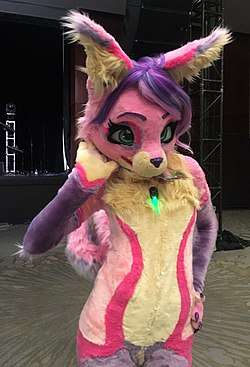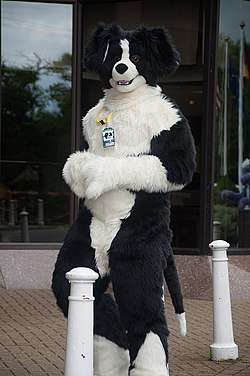Fursuit
Fursuits are custom-made animal costumes owned and worn by cosplayers and members of the furry fandom, commonly known as "furries"; a furry who wears a fursuit is called a fursuiter.[1]:13 The term is believed to have been coined in 1993 by Robert King. Unlike mascot suits, which are usually affiliated with a team or organization, fursuits represent an original character created by their wearer, and are often better-fitting and more intricately crafted, with features such as a moving jaw.[2] Fursuits are made in a wide range of styles, from cartoonish to highly realistic.




| Part of a series on |
| Costume |
|---|
 |
|
Background
|
|
Society and culture |
|
Elements and methods |
|
Children |
|
Fictional |
|
Organizations |
|
People
|
|
Museums
|
History
The concept of a fursuit can be traced decades prior to the term "fursuit" ever being coined, to at least as early as 1947, with a German Shepherd dog suit being a core plot element of Edwin Corle's Three Ways to Mecca.[3] However, although an early, genderbending fursuit appeared at the first ever furry convention in 1989, fursuits did not become widely known until the mid-1990s and the rise of the Internet.[2] Most early fursuit making was done on a hobby basis using guides released by members of the community. However, by the mid-2000s, fursuits were in such high demand that fursuit making became a viable business.[2] Including used suits, the industry now sells millions of dollars worth of suits each year, and organizations such as sports teams are increasingly commissioning mascots as custom-made fursuits.[2]
Fursuit construction
Fursuits originated due to the dissatisfaction with the quality of mass-produced mascot costumes.[4] Fursuit making is a growing industry, with new costume makers who handcraft custom suits entering the market every week.[5] A few dozen of these makers are highly respected and command prices up to $4,500 or more for a full suit, while there are several hundred more who charge less, usually between $1,000 and $3,000.[2] Some of these, however, are "fly-by-night" operations or make suits of sub-par quality, leading to the proliferation of fursuit review sites to weed them out.[2] There is heavy turnover of these smaller makers, with only a third of them able to stay afloat, due to suit-making being labor-intensive, and requiring a unique style and a following.[2]
People also sometimes make fursuits from scratch as a hobby without opening a business themselves.[6]
In order to make them fit correctly, many fursuit makers utilize "duct tape dummies" that are made of the wearer's body.[7] They are made with faux fur that is sometimes sourced from places like the Los Angeles Fashion District.[5] A single suit can take more than 200 hours of work and sell for thousands of dollars.[5][8][4]
Fursuits can be expensive to clean,[9] although many modern-day suits are machine-washable.[5]
Types of fursuits
Besides the typical full-body suit, the partial suit, where the suit's body is substituted by normal clothing, is a popular variation. Three-quarter suits only include part of the body, like the torso or legs, appearing similarly to a funny animal character.[1] Quadsuits are one of the most challenging and expensive types of costumes to make, and involve the wearer walking on all fours with arm extensions to create the illusion of a real animal.[10] A plush suit is a suit that is made to look like a stuffed animal/plushie.[11] There are also fursuits made of other materials, such as spandex or latex.[12]
Fursuits can range from cartoon-styled to hyper-realistic.[4] The most popular animals for fursuits to be based on are dogs and big cats.[5] They may also be based on fictional animal hybrids.[5] Some suits may include integrated technology, such as LED lights and programmed expressive eyes.[5]
In culture
Fursuits are heavily associated with the furry fandom by the general public, despite the fact that only 15 percent of its members own a fursuit, mainly due to their cost being prohibitively high.[6] They may also be seen as overtly sexualized due to negative coverage from shows like CSI, though this is typically not the case.[2] Furries who own a fursuit often base them on a "fursona", an anthropomorphic character that represents themselves.[4] Dedicated fursuiters may own as many as a dozen suits based on different characters.[2] Despite being stigmatized as "bizarre", many members of the furry fandom aspire to be society's highest earners, in part to afford expensive fursuits and associated furry art.[13]
Fursuits are usually worn to furry conventions such as Midwest FurFest and Anthrocon.[4] Some fursuits of existing characters are made for the purposes of cosplay and are worn to anime or gaming conventions. They are also worn in public, though this often requires a spotter or handler to ensure the safety of the performer from things like rowdy people, exhaustion or accidents due to limited vision.
See also
- Creature suit
- Costumed character
- Cosplay
- Furry Fandom
References
- Riggs, Adam (2004). Critter Costuming: Making Mascots and Fabricating Fursuits. Ibexa Press. ISBN 0-9678170-7-2.
- "Who Makes Those Intricate, Expensive Furry Suits?". Vice. 2017-07-27. Archived from the original on April 21, 2020. Retrieved 2018-02-06.
- Corle, Edwin (1947). Three Ways to Mecca. New York: Duell, Sloan, and Pearce.
- Brown, Meg (2017-03-26). "The Fursuit of Happiness". Terrain.org: A Journal of the Built + Natural Environments. Retrieved 2017-07-30.
- Wall, Kim (2016-02-04). "It's not about sex, it's about identity: why furries are unique among fan cultures". The Guardian. ISSN 0261-3077. Retrieved 2017-07-17.
- "'It's Not a Fetish': An Interview with One of the World's Leading Furry Researchers". Vice. Retrieved 2017-07-17.
- "Furries Tell Us How They Figured Out They Were Furries". Vice. Retrieved 2017-07-17.
- "'Furries' Descend On Golden Triangle". WTAE-TV. June 16, 2006. Archived from the original on July 3, 2006. Retrieved 2006-06-30.
- Maass, Dave (2007-10-07). "Fluff Piece". Santa Fe Reporter. Archived from the original on 2013-02-02. Retrieved 2008-04-03.
- Parker, Sydney (2015-07-09). "The Fursuit of Happiness: High Fashion in Furry Fandom". Racked. Retrieved 2017-07-17.
- https://www.skyprocostumes.com/ordering
- Sxaleworx https://web.archive.org/web/20180624154233/http://www.scaleworx.org/. Retrieved 11 October 2019. Missing or empty
|title=(help) - "The one fur cent: inside the lives of the world's richest furries". www.newstatesman.com. Retrieved 2019-03-11.